Guacamelee 2 Review
The Chosen Juan returns to a ring littered with contenders.
This article first appeared on USgamer, a partner publication of VG247. Some content, such as this article, has been migrated to VG247 for posterity after USgamer's closure - but it has not been edited or further vetted by the VG247 team.
Back when the first Guacamelee came out, the indie gaming market wasn't too shy about making games in the style of Metroid. Indie developers haven't held off the throttle since then and the genre is practically stuffed these days. I've played Hollow Knight, reviewed Dead Cells and Chasm, and Kat's currently working on Death's Gambit. That's all in the past few months.
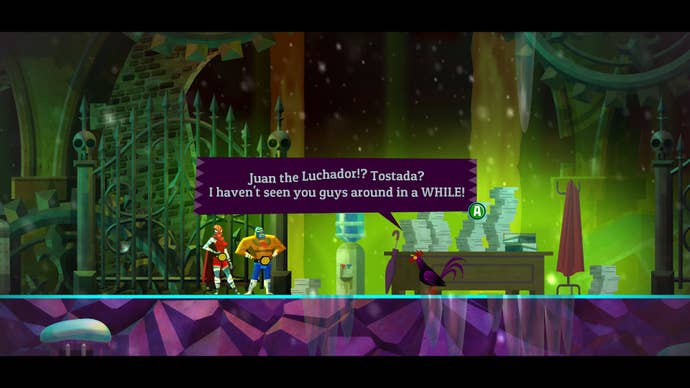
Guacamelee 2 does stand out in the ring though. Developer Drinkbox Studios already crafted an excellent adventure game the first time around. Guacamelee 2 carries forward that distinctive art style and tone, which already puts the game ahead of some of the competition. This is also the only game in the genre that can be played cooperatively with up to four players. That's a very weird addition, but I'm not judging.
Guacamelee 2 remains the story of luchador Juan Aguacate. It's been seven years since the last game. Juan defeated Calaca, saved the world, married El Presidente's Daughter, and settled down. He's got two kids and lost his lean fighter's body. But then the sky is torn asunder and old goat monk Uay Chivo returns to ask for Juan's help. It's time to put the mask back on and deal out some lucha justice.
See, Juan is the last surviving Juan in all the Mexiverse. In the Darkest Timeline , evil luchador Salvador was the one to defeat Calaca and he's gone rogue with power. Now he wants to collect three legendary relics that will lead him to the Sacred Guacamole of Tiempochtli, which will give him ultimate control over reality. So the Council of Uay Chivos have banded together once again to trust in their last hope.
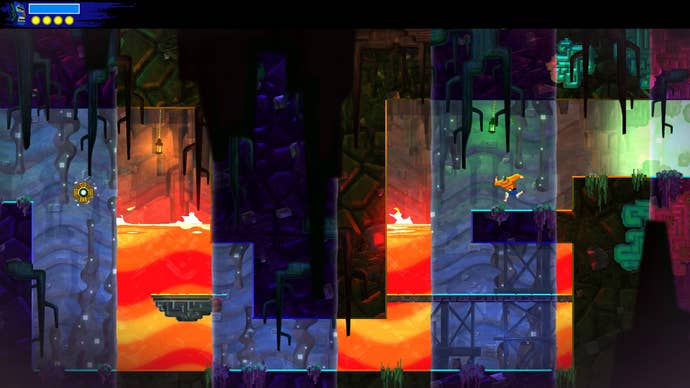
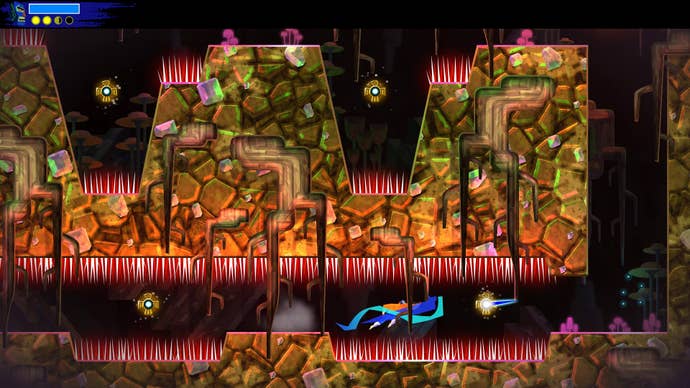

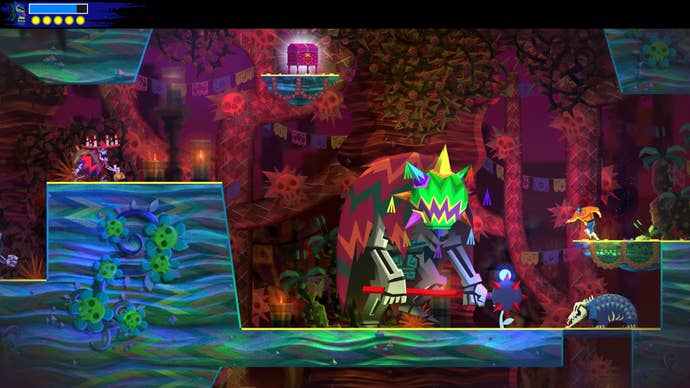
Yeah, I didn't make up any part of that preceding paragraph. It's true. All of it.
That last quote is a reference to pop culture, which is part of Guacamelee 2's wallpaper. Like the first game, you'll see small references to Black Panther, He-Man, and Sonic the Hedgehog. I ran into levels that were callbacks to fellow indie Limbo, beat-em-ups like Bad Dudes and River City Ransom, Street Fighter II's bonus stage, and even turn-based RPGs. Guacamelee 2 never stays on one reference for too long, touching upon it and then moving on to the rest of the game.
The core combat remains from the first title, working almost like a fighting game. Juan has a series of moves that are bound to different button and directional pad combinations; unlike many other Metroidvania titles, there's nothing to equip. A number of his moves from the first game are back in action, slightly renamed. Moves like the Rooster Uppercut, Frog Slam, and Dimension Swap are the same, while Olmec's Headbutt is now KO Headbutt. Dodging is the meaty center of combat and traversal, allowing you to slip between traps and attacks with a well-timed button press.
Drinkbox has filled out Juan's repertoire with some new options too. Juan has a new grappling hook-style ability called the Eagle Boost. The rest of the new moves have been offloaded on the Pollo Power chicken form. The chicken can still fit into spaces too small for Juan, but you can also shoot diagonally upwards or downwards, float on wind currents, or do a vicious attack slide. Every attack move across both forms is color-coded; use the right move on the door or button with a similar color, or to remove an enemy shield of the same color. Generally, the issue in Guacamelee 2 isn't knowing what you need to do, it's seeing if you have the dexterity to do it.
I'm tempted to ask who hurt Drinkbox Studios enough to make the entire studio become such misanthropes. Guacamelee 2 does have a few challenging combat encounters, but the lasting sting comes from the platforming. Even on the game's critical path, there are some absolutely vicious sections of platforming madness. You will fail and you will die. Sections will have you jumping, switching dimensions, doing a Eagle Boost, switching dimensions back, double jumping, and ending with a Rooster Uppercut in quick succession to move forward. Luckily, Drinkbox is kind with the checkpoints, so it's rare that a death sends you back very far. This makes the player lean harder on trying each section one more time, since you never feel like you're losing any time to the game. Guacamelee 2 is not La-Mulana hard, but it will test some folks.
As you defeat enemies, you'll pick up gold, which you'll then spend on upgrades with various trainers. There are a total of five trainers in the game, each with a different focus. Fitness guru Dony Chamoya (I love her) will upgrade your basic health and stamina, old foe Flame Face improves your Hit Meter and Combos, wrestler Coscorrona upgrades your wrestling moves, Rooster Ramirez makes your chicken powers meatier, and the Yoda-like Uay Coco increases the strength of your special moves. It's a pretty straightforward upgrade system, it's just a matter of what you want to improve first.
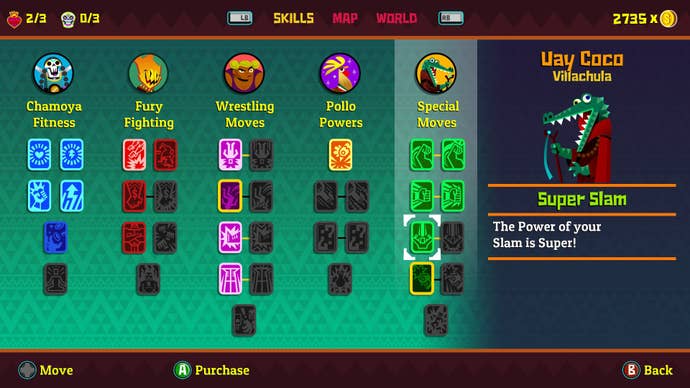
In fact, Guacamelee 2's supporting cast remains one of its stronger points. Many of them are quite stupid, but they're also fun. Old bosses Flame Head, X'Tabay, and Jaguar Javier return here in less antagonistic roles. The Council of Uay Chivos all have slightly different points of weirdness to them. There are also others characters, like a young boy painstakingly making a statue of his favorite luchador, who will briefly cross your path. This isn't a deep story, but the cast entertains.
My major problem with Guacamelee 2 is one of input. Perhaps it's because I've also been playing Dead Cells recently and the controls are so tight there. I feel Guacamelee 2 isn't as responsive as it could be, especially with the fairly tight timing needed for platforming sections. Sometimes I've done the button combination for a Rocket Uppercut or Wall Hang, only for Juan to do nothing and fall into the fire or spikes.
Two, mapping every move to controller inputs mean there are situations where you want to pull off one move and you do another. For example, the KO Headbutt is neutral on the directional pad and the B button, but since you're usually moving, trying to pull off one in combat leads to doing one of the other moves. Given how unforgiving combat and platforming can be, it can get a bit frustrating when you feel like the game let you down.

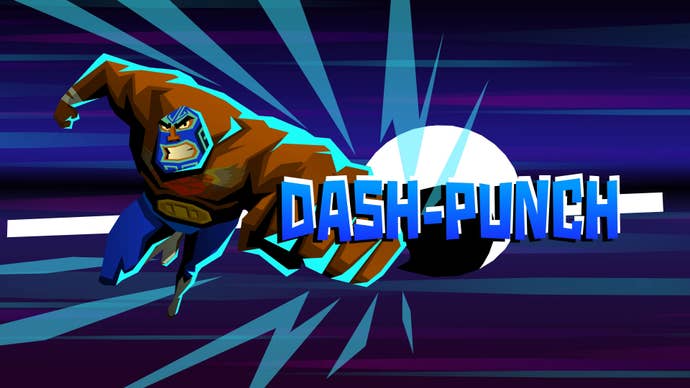
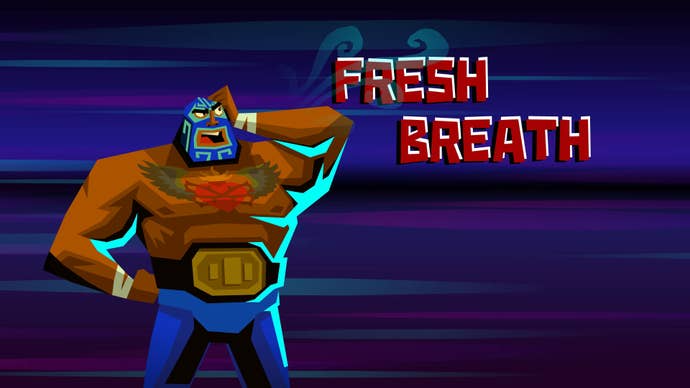
None of this gets in the way of most of Guacamelee 2 though, which settles in next to its predecessor and looks effortless while doing so. The humor is hit or miss, but someone enjoyed putting this game together. It's absolutely gorgeous to look at, as the levels simply pop in bright, beautiful colors. Every region even has two looks thanks to dimension switching between the land of the dead and living. The soundtrack is a winner; it's not the best I've heard this year, but it combines the standard dungeon diving soundtrack with appropriate Latin influences. And you don't have to play Guacamelee 2 alone, as cooperative play is drop-in, drop-out.
Juan's second adventure is good enough to stand out in a market of strong contenders. It leans on the harder side of the genre, but it's not vindictive in its difficulty. And the art style and tone go a long way towards endearing you to the game and its world. Much like the first, Guacamelee 2 can stand in the winner's circle with pride.
ConclusionGuacamelee 2 builds on the same charm and platforming core as the first game. The Metroid-style adventure returns with its luchadore flavor, a host of pop culture references, and some vicious platforming. The art style is the same, but the levels look absolutely stunning now and the music plays heavily with Latin influences. Having special moves bound to directional and button inputs means your chosen attack can get lost in the heat of battle and sometimes it feels like the game isn't responding to certain inputs. Despite those problems, Guacamelee 2 is still a great sequel.


